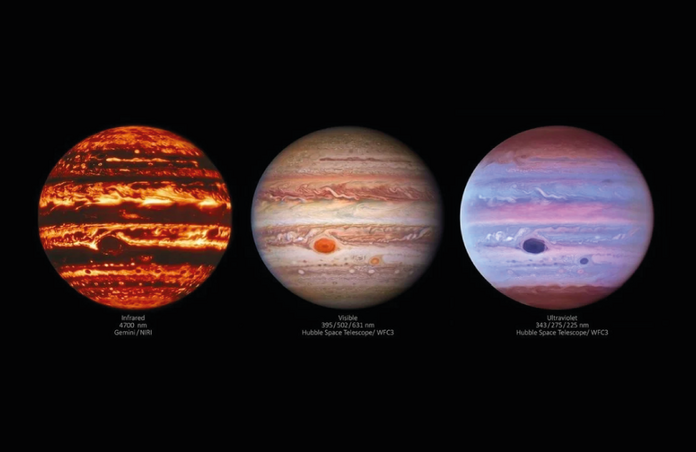Amazing Images of Jupiter at Different Wavelengths

Images of Jupiter taken by the Hubble Space Telescope and the Gemini observatory reveal details about the giant planet’s stormy atmosphere.
Jupiter’s most famous feature is the Great Red Spot, although “smaller” features like Red Spot Junior (which is still three times the diameter of the Earth) also hint at the presence of stormy winds in its atmosphere. Thanks to the multiwavelength observation conducted with the HST for visible and ultraviolet images and the Gemini North telescope for the infrared ones, now released by the National Science Foundation's National Optical-Infrared Astronomy Research Laboratory, astronomers were able to study Jupiter’s atmosphere over a range of wavelengths but at the exact same point in time.
Seen in visible light, Jupiter looks like what most people imagine when they hear Jupiter: details like the red spots or its “stripes”, lightly coloured zones and darker belts, are visible; however, the thickness of the clouds can’t be measured. For that, an IR view can help, since thinner regions will allow more of the thermal energy to escape. These are seen as yellow features, while dark red indicates denser clouds. UV light is mostly used to determine the distribution of particles, as photons at UV wavelengths get absorbed at high altitude but get reflected at lower altitudes. The latter therefore appear blue while higher layers appear red.
The most intriguing result is how in IR, the Great Red Spot disappears although some “holes” can be spotted. These are thought to be turbulences, much like eddies in the ocean: as the water, or in this case the gas, spins, small anomalies can appear. Red Spot Junior is also not to be seen on the IR image. It was formed almost 100 years ago when three smaller storms merged, and only began to turn red in 2005 due to a process that remains mysterious - two theories that have been put forward are on one side interacting between gases in the storms and high-energy photons from the Sun, or it could be that the winds are powerful enough to lift gases from lower layers of the atmosphere, which get their red colour when exposed to sunlight.
In 2019, radio observations with the ground-based Atacama Large Millimetre/Submillimetre Array telescopes already gave an insight into the distribution of ammonia gas below the surface clouds. Thanks to further observations in the radio regime with the Juno probe, which reached Jupiter in 2016 and just had its mission extended until 2025, lightning strikes have been found in the darker streaks of the Great Red Spot.
Jupiter’s Red Spots haven’t revealed all their secrets yet – more multiwavelength observations will help astronomers understand the Jovian weather.
Cover Image: International Gemini Observatory/NASA/ESA/NOIRLab/NSF/AURA/M.H. Wong and I. de Pater (UC Berkeley) et al./M. Zamani
Image Credits:
1 - NASA/ESA/NOIRLab/NSF/AURA/M.H. Wong and I. de Pater (UC Berkeley) et al.
2 - International Gemini Observatory/NOIRLab/NSF/AURA, M.H. Wong (UC Berkeley) et al./M. Zamani
3 - ALMA (ESO/NAOJ/NRAO), I. de Pater et al.; NRAO/AUI NSF, S. Dagnello
4 - ALMA (ESO/NAOJ/NRAO), I. de Pater et al.; NRAO/AUI NSF, S. Dagnello; NASA/Hubble
